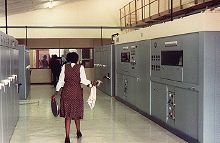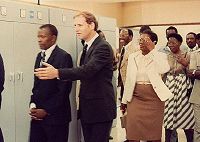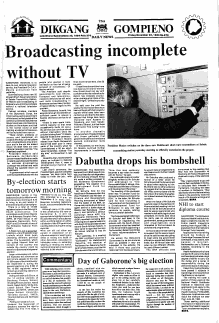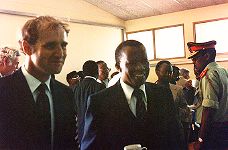
A last dust before the President arrives...
(click to enlarge)
I mentioned earlier the Southern Africa Development Coordination Conference (SADCC). Because of Botswana's pivotal position as one of the front-line states the Government was heavily involved in the efforts to free the region from dependence on the racist South African economy. This was not an easy task since most of the sea ports and transport infrastructure were controlled by Pretoria (see the map from an earlier section.) After the elections at Zimbabwean independence - an event which inspired one newspaper to report with the headline "Whites Fooled By Their Own Propaganda" - Gaborone was chosen as the seat of the SADCC secretariat.
A year or so later Botswana played host to the inaugural conference, amid world-wide publicity and huge security. For every SADCC country was represented and there was even more press interest than at the funeral of Sir Seretse Khama a couple of years earlier. Of course, there was only one sufficiently equipped and secure place where such an august group of leaders could hold its press conferences. Yes - you've guessed it. It was quite fun to have eight Heads of State all at once in our main music studio!
At the time of the SADCC conference the building works and aerials at Sebele transmitting station had almost been completed. These were necessary in order to house "The Big One" (E Tona) as the the RIZ 50kW unit had come to be known. In fact we asked President Masire to come up and switch it on in 1983. So when the three new Siemens transmitters eventually did arrive in early 1984 we were able to install them relatively quickly. We made extensive trips around the country to monitor reception as they were brought into service. It was during this period that we modified one of the then new Sony digital portable receivers (the ICF-2000) to allow it to be controlled by a computer. The project is written up here (SMARTIE) but essentially it turned a $300 transistor radio into a sophisticated scanning receiver at a time when similar commercial devices might have cost several thousand US dollars. I wrote some software for a $500 BBC microcomputer (for we had imported the first two into Botswana a year earlier!) and the resulting combination could be placed hundreds of kilometers away. I downloaded the reception data at the end of each day by telephone (at 300 Baud!). It doesn't sound very difficult these days but it seemed almost magic in the early 1980s.
 VIPs hear from President Masire how the new transmitters will dramatically improve reception. I stayed up most of the night writing that speech! If you know anything about audio amplifiers and high power radio transmitters you might sympathise with the problems of providing public address on the site . . . (click to enlarge) |
In his speech, reported below (click on the thumbnail of Dikgang tsa Gompieno - the Daily News) President Masire commented that ". . . a government which cannot communicate effectively with the people who elected it must inevitably run the risk of being accused of remoteness."
Now that these new transmitters had been put in, the President continued, ". . . for the first time Government can say with confidence that the national radio station has complete country-wide coverage at all times of day and night." |
| Then it was time to formally switch on the new Siemens transmitters. We all moved from the car port outside into the main building, admiring the workshop and various other extremely uninteresting features on the way. For a few moments we deliberately switched off all the Radio Botswana broadcasts. |  The President is shown into the new transmitter hall (click to enlarge) |
 The Daily News catches the moment as President Masire switches on the first of the three new 50 kilowatt short-wave transmitters at Sebele (click to enlarge: filesize=161K) |
I invited the President to press the appropriate buttons and - with a roar of fans and a clatter of solenoids - we had three powerful shortwave transmissions blanketing the country. It's the nature of these things that actually there was not a lot to see at Sebele, but we certainly received appreciative comments from the listeners. And the President had also mentioned television and a commercial radio station in his speech - they were some years off but at least now they were on the development agenda. |
| Well, I had written the drafts for Government speeches before - almost every year since 1979 in fact, as our Minister, Hon. Daniel Kwelagobe was grilled by the Public Accounts Committee in Parliament over our annual estimates. But it was quietly pleasing to hear Ted's, Kinnear's and my vision for the next ten years and more being laid out in public by the President. The television didn't arrive until 2000. The commercial radio station (RB2) was some years earlier. Voice of America did get their massive expansion at Selebi-Phikwe in the end. And I left Botswana less than a fortnight later. |  Relaxing with a cup of tea after the switch-on |
PostscriptJust days before I left, I was summoned to the Office of the President. I expected to see our Minister Kwelagobe, but to my surprise, I was ushered into see President Masire himself. And for an hour we chatted over coffee and biscuits about how I saw Botswana's broadcasting developing in the years ahead. I felt immensely privileged to hand on the accumulation of ten years' work. In future years, as I followed Botswana's progress via the World Radio and TV Handbook and later on the World Wide Web, I looked through the mementos of those ten years with great pride. I hope you have enjoyed reading about it too. |
|